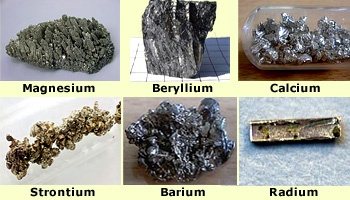

Formation of Peroxides on HeatingĪlkali Metals: Alkali metals form peroxides when heated.Īlkaline Earth Metals:Alkaline earth metals except Barium do not form peroxides. Nature of Bicarbonates at Room TemperatureĪlkali Metals: Bicarbonates of alkali metals exist in solid form.Īlkaline Earth Metals: Bicarbonates of alkaline earth metals exist in solution form.

Stability of Hydroxides on HeatingĪlkali Metals: Hydroxides of alkali metals are stable.Īlkaline Earth Metals:Hydroxides of alkaline earth metals form oxides. Heating of NitratesĪlkali Metals: Nitrates of Alkali metals give corresponding nitrates and oxygen as products.Īlkaline Earth Metals:Nitrates of alkaline earth metals give corresponding oxides, nitrogen dioxide and oxygen as products. Decomposition of CarbonatesĪlkali Metals:Carbonates of alkali metals do not decompose.Īlkaline Earth Metals: Carbonates of alkaline earth metals decompose to form oxide when heated to high temperatures. Nature of the Metal HydroxideĪlkali Metals: Hydroxides of alkali metals are strongly basic.Īlkaline Earth Metals: Hydroxides of alkaline earth metals are relatively less basic. Melting PointsĪlkali Metals: Alkali metals have low melting points.Īlkaline Earth Metals:Alkaline metals have relatively high melting points. Nature of the MetalĪlkaline Earth Metals: Alkaline earth metals are hard. These metals are the most reactive of all the metals on the periodic table.įigure 1: Periodic table showing alkali and alkaline earth metalsĭifference Between Alkali Metals and Alkaline Earth Metals Number of Electrons in the Outermost Shell of an AtomĪlkali Metals:Each alkali metal has a single electron.Īlkaline Earth Metals: Each alkaline earth metal has two electrons. Unlike most of the other metals, the alkali metals are soft with low densities and low melting points. The electron-donating tendency increases down the group since the positively charged nucleus has less attraction forces towards the outermost electron due to the presence of more electron filled inner shells. All the alkali metals are ionic and show electrovalency. By donating the single electron in the outermost shell to an electron-accepting atom, these metals become positively charged and obtain the electronic configuration of a noble gas. These metals include lithium, sodium, potassium, rubidium, cesium and francium. These metals are placed in Group IA of the periodic table. What is the difference between Alkali Metals and Alkaline Earth MetalsĪlkali metals are the elements that possess only one valence electron in their outermost shell.

– Definition, Characteristics, Properties, Examplesģ. The main difference between alkali metals and alkaline earth metals is that alkali metals have one valence electron in the outermost orbit whereas alkaline earth metals have two valence electrons in the outermost orbit. All the metals in the periodic tables are classified into three groups, namely alkali metals, alkaline earth metals, and transition metals. Metals are placed on the left-hand side and middle part of the periodic table. Metals are the elements that have some unique set of properties including, excellent electricity and thermal conductivity, and luster. Non-metals are the elements that do not possess any property of metals. Metalloids are the elements that possess certain properties of both metals and non-metals. Inert gasses are the elements with zero reactivity due to the presence of stable outermost octet. Main Difference – Alkali Metals vs Alkaline Earth MetalsĪll the elements on earth can be categorized into metals, non-metals, metalloids and inert gasses.


 0 kommentar(er)
0 kommentar(er)
